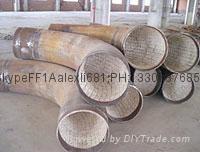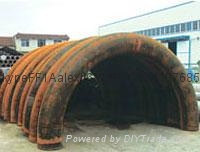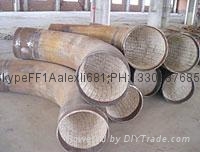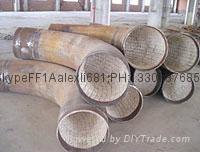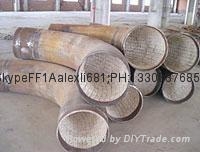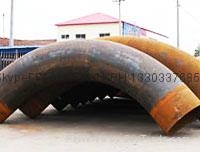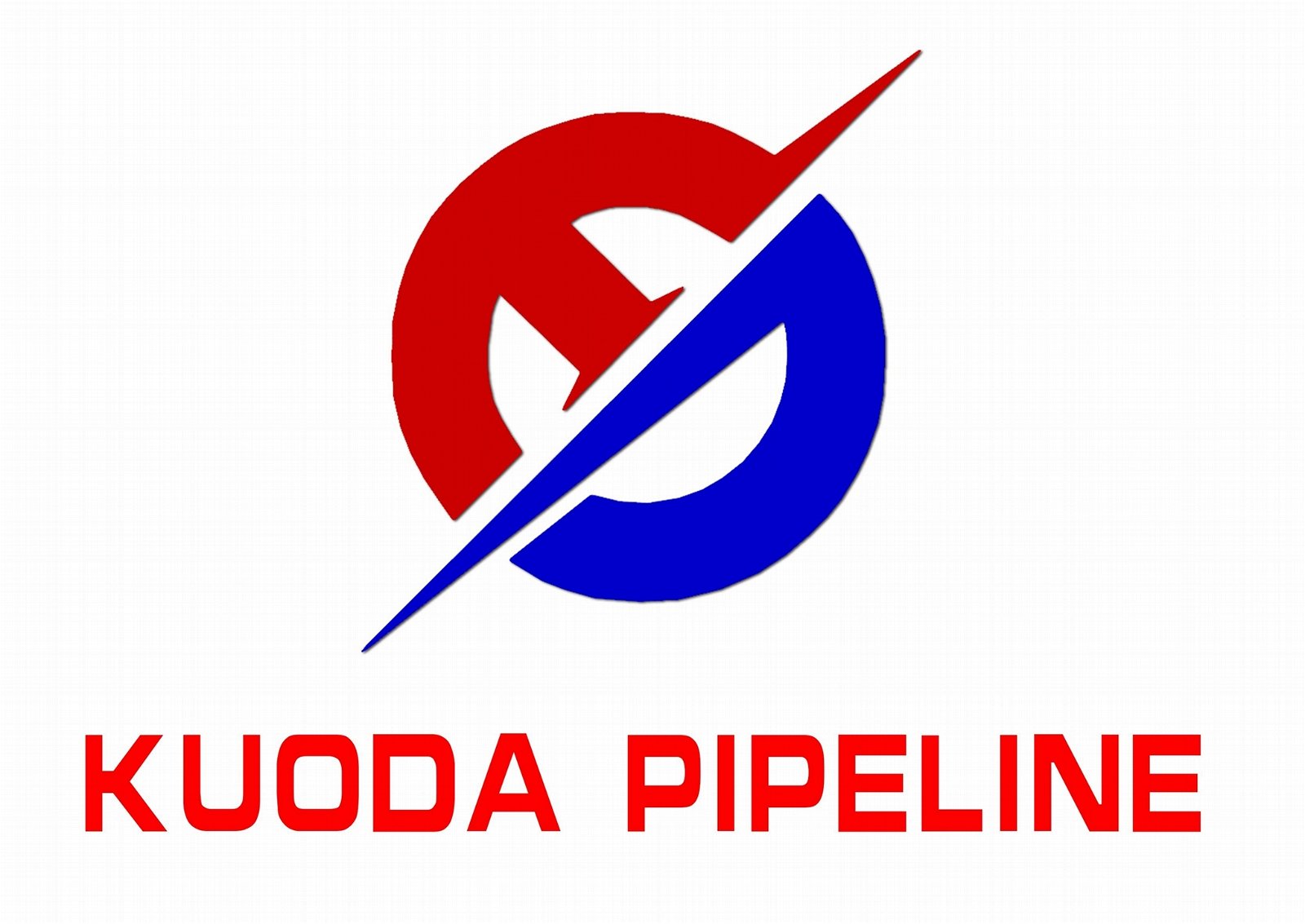Product Description
Intermediate frequency bend is stay in steel pipe bending part set on the induction coil, mechanically pivoted arm stuck pipe head, zhongtong into the intermediate frequency induction coil current heating tube, when the steel tube temperature to the plastic state, after the steel pipe end with mechanical thrust forward, bending, bending of making steel pipe section with coolant cooling rapidly, so that heating, while advancing, bending, while cooling, constantly to bend pipe bending.
Intermediate frequency bend is currently widely used in electric power, petroleum, chemical industry, navigation, nuclear industry and other projects in the field of piping prefabrication, but medium frequency bend in striking place fold obvious big waves, especially the bending radius is less than 3 Do (Do) for the tube diameter, the inner arc fold larger waves, the serious influence the appearance of the product quality, this is for decades domestic pipe bender can't solve problems that also need.
Features: 1. The intermediate frequency bend USES vertical external characteristic of power supply, dc when using normal polarity (wire connect cathode)
2. Intermediate frequency bend generally suitable for thin plate welding, under 6 mm weld moulding beauty, weld the characteristics of small deformation
3. The protective gas for argon, the purity of 99.99%. When the welding current is 50 ~ 50 a, the argon gas flow is 8 ~ 0 l/min, when the current is 50 ~ 250 a, argon gas flow is 2 ~ 5 l/min.
4. The welding arc length, welding of ordinary steel, with 2 ~ 4 mm is better, and when the welding stainless steel, it is beautiful ~ 3 mm, too long is bad protection effect.
5. Intermediate frequency bend to prevent welding porosity appear, welding parts such as rust, oil, etc. Be sure to clean up.
6. The length of the tungsten electrode from the gas nozzle is prominent, for beautiful, with 4 ~ 5 mm, poor shelter place such as in the fillet weld is 2 ~ 3 mm, where the slot depth is 5 ~ 6 mm, nozzle distance to work is generally not more than 5 mm.
7. Intermediate frequency bend docking render, to prevent the bottom on the back of weld bead was oxidized, also need to implement gas protection on the back.
8. Wind and ventilation. There is wind, please backstop measures, while indoors is the proper ventilation measures should be taken.
9. Intermediate frequency bend for the argon gas protection welding molten pool very well, and facilitate the welding operation, the center line of the tungsten electrode and welding workpiece generally should maintain 80 ~ 80 ° Angle, Angle of filler wire and workpiece surface should be as small as possible to 0 ° or so commonly.
Classification: 1. To material classification:
Carbon steel, ASTM/ASME A234 WPB, WPC
Alloy: ASTM/ASME A234 WP 11-12-1 - WP WP WP 22 - WP 5 - WP 91-35 crmov WP911, 15 mo3 15 crmov,
Stainless steel, ASTM/ASME A403 WP 304-304 - l - 304 - h - 304 ln - 304 n
ASTM/ASME A403 WP 316-316 l - 316 - h - 316 ln - 316 - n - 316 ti
ASTM/ASME A403 WP 321-321 - h ASTM/ASME A403 WP 347-347 - h
Low temperature steel, ASTM/ASME A402 WPL3 - WPL 6
High performance steel: ASTM/ASME A860 WPHY 42-46-52-60-65-65
Cast steel, alloy steel, stainless steel, copper, aluminum alloy, plastic, argon luo drain, PVC, PPR, RFPP (reinforced polypropylene), etc.
2. By producing method can be divided into pushing, pressing, forging, casting, etc.
3. To make standard classification can be divided into the national standard, standard, vessel standard, standard, water standard, American standard, Germany standard, Japanese standard, the standard and so on.
4. According to the radius of curvature points: can be divided into long radius elbow and short radius elbow. Long radius elbow refers to its radius of curvature is equal to 1.5 times the outer diameter of tube, R = 1.5 D. Short radius elbow refers to its radius of curvature is equal to the pipe diameter, R = 1.0 D. To bend diameter (D, R for the radius of curvature). 5. If according to the grades of pressure points: about seventeen kinds, and American standard pipe is the same, there are: Sch5s, Sch10s, Sch10, Sch20, Sch30, Sch40s, STD, Sch40, Sch60, Sch80s, XS; Sch80, SCH100, Sch120, Sch140, Sch160, XXS; One of the most common is two kinds of STD and XS.
Due to the
Intermediate frequency bend pipe has good corrosion resistance, so it can make structure parts permanently maintain the integrity of engineering design. Chromium stainless steel stamping elbow also has high mechanical strength and extensibility, easy processing and manufacturing of parts and can meet the needs of architects and structural designers. All metal and atmospheric oxygen in the reaction, formed in the surface oxide film. Unfortunately, in the ordinary carbon steel formed on the oxidation of iron oxide to continue, kept expanding rust, eventually forming holes. Can use paint or resistant to oxidation of metal plating to ensure that the carbon steel surface, but, as we know, the protection is only a thin film.
The corrosion resistance of medium frequency bend depends on the alloy element content in the steel. Chromium stainless steel stamping elbow is get the corrosion resistance of the basic elements, while about 1.2% chromium content in steel, chromium and oxygen effect of corrosive medium, in the steel surface to form a thin layer of oxide film (since the passivation film), but to prevent further corrosion of steel substrate.
Intermediate frequency bend resistance to weak corrosive medium such as air, steam, water and acid, alkali, salt and other chemical etching medium corrosion of the steel. Also called acid-proof stainless steel. In practical application, often called the weak corrosive medium corrosion resistant steel stainless steel stamping elbow, and called the resistance to chemical corrosion medium steel acid-resistant steel. Due to the chemical composition on the difference between the two, the former does not necessarily medium resistance to chemical corrosion, while the latter are generally not rust. Intermediate frequency of bend forming process is complicated, need according to the use of the different material and welding, gradually forming under the certain pressure. Intermediate frequency of bend forming shall be carried out according to certain procedure, strictly abide by the corresponding process flow, otherwise the production of intermediate frequency bend can produce quality problem.
Viscous medium frequency bend pipe quality is higher, chip breaking performance is poor, so in stainless steel pipe bending prone to chip in the process of using threading tap scratch artifacts thread or tap the phenomenon such as collapse edge, affect the efficiency and the quality of thread. Intermediate frequency bend according to the material can be divided into: carbon steel medium frequency bend, stainless steel medium frequency bend, alloy steel intermediate frequency bend; According to the standard can be divided into: national standard intermediate frequency bend, non-standard intermediate frequency bend, international standard, Germany standard, Japanese standard, American standard, British standard intermediate frequency bend. Now to understand the knowledge about carbon steel medium frequency bend.
Intermediate frequency bend pipe is widely used in industry of our country. Intermediate frequency bend according to long-term production making, summarized in the many failures, a reasonable science and new experience, add a certain amount of rare earth elements to improve the quality of alloy steel. In electric power, mining, metallurgical and other industries, material conveying, output, are using at close range, high pressure conveying, pipeline under considerable pressure, and sustained serious wear and tear of pipe is very difficult to satisfied the condition of single material requirements.
The use of intermediate frequency bend pay attention to the main point: 1), in order to prevent the result of the heat corrosion between eyes, welding current shoulds not be too big, is about 20% less than that of carbon steel electrode, arc shoulds not be too long, interlayer cold quickly, with narrow bead advisable. 2), intermediate frequency elbow sclerosing after welding is bigger, is easy to crack. If using the same type of intermediate frequency bend welding, must be above 300 ℃ preheat and 700 ℃ or so slow cooling after welding. If cannot undertake the weldment heat treatment after welding, the electrode should be chosen medium frequency bend. 3), intermediate frequency bend pipe coated with titanium calcium type and low hydrogen type. Titanium calcium type can be used for ac/dc, but when the ac welding penetration was relatively shallow, at the same time easy to red, so using dc power supply as much as possible. 4),
Intermediate frequency bend, in order to improve the corrosion resistance and weldability and appropriately increased moderate stability element Ti, Nb and Mo, weldability medium frequency bend after some relatively. Using the same type of chromium stainless steel electrode, should be above 200 ℃ preheat and around 800 ℃ tempering treatment after welding. If cannot undertake the weldment heat treatment, should choose chromium nickel stainless steel electrode. 5), intermediate frequency bend, when welding the carbide precipitation by repeated heating, reduce corrosion resistance and mechanical properties. 6), intermediate frequency bend electrode has good corrosion resistance and oxidation resistance, widely used in chemical, chemical fertilizer, oil, medicine, machinery manufacturing.
Payment Terms︰
TT
Product Image
